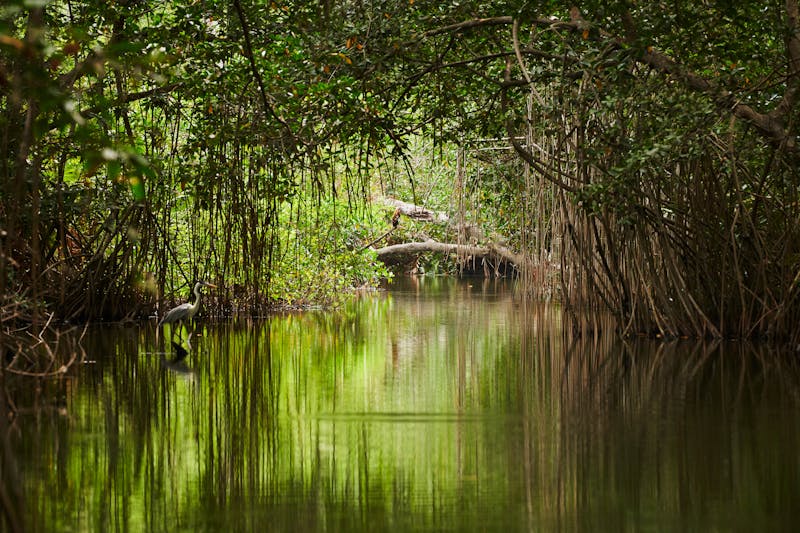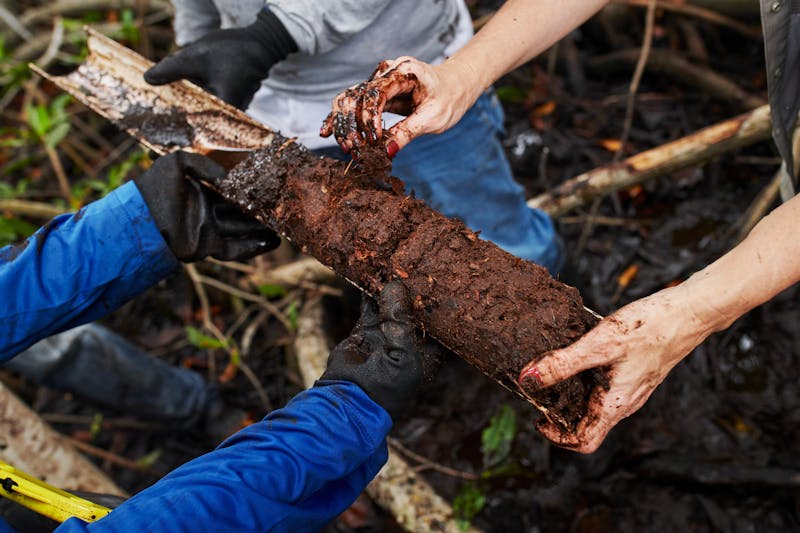Hugging coastlines throughout the tropics, mangroves are climate superstars. In a single square mile, their dense tangle of roots can stash away as much climate-warming carbon as the annual emissions of 90,000 cars.
But, until now, this “blue carbon” — that is, carbon stored in coastal ecosystems — hasn’t been adequately and accurately measured. This has effectively shut mangroves out of carbon markets, precluding financial incentives to protect them and depriving coastal communities of potential income.
That is about to change — with major implications for the survival of mangrove forests, which for decades have been decimated for agriculture, shrimp farms, urban development and more.
A recently-launched blue carbon finance project for the first time takes into account not only the carbon that mangrove trees store in their trunks and leaves, but also the carbon they sequester in their soils, often for millennia.

An 11,000-hectare (27,000-acre) in Cispatá Bay on the Caribbean coast of Colombia. (© Apple)
“In most terrestrial forests, soil gets ignored because it only contains a small proportion of the total of carbon,” said Jennifer Howard, who heads Conservation International’s Blue Carbon Program. “But when it comes to wetlands like mangroves and marshes, soil is the most significant source of carbon in the ecosystem. If we ignore the soil, we’re simply leaving money on the table.”
Developed by Conservation International and partners — including Colombia’s Marine and Coastal Research Institute (INVEMAR) and the country’s Environmental Authority — the project creates a long-term funding opportunity that is expected to conserve and restore mangroves in Cispatá, an 11,000-hectare (27,000-acre) mangrove forest along Colombia’s Caribbean coast.
Scientists there used a simple but effective system for measuring the carbon locked away in the tropical sediment: Wading into the mangroves, they used a special pipe to extract soil one to three meters deep. The soil’s carbon content was then analyzed in a lab.
“The muck we pulled up hasn’t seen the light of day for 100-plus years,” Howard said. “It’s not pretty, but this blue carbon is vitally important in the effort to address global climate change and help end mangrove destruction.”

For an accurate soil sample, Conservation International and Invemar’s field team uses a sediment core sampler to extract a depth of 500 millimeters (50 centimeters) and measure carbon stocks and length of time it’s been stored. (© Apple)
With its carbon stores fully calculated by the Verified Carbon Standard and the Climate, Community & Biodiversity Standards, the most widely used programs for certifying emissions reductions, the Cispatá forest can now be valued for its climate benefits and included in carbon markets. This critical step opens a path for other blue carbon ecosystems around the world to be added to those markets.
In addition to storing carbon, mangroves provide a powerful defense against the impacts of a warming planet. These natural buffers can help millions of people in coastal communities become more resilient to sea-level rise, blunting storm surges and floods. In fact, a study of developing countries subject to storms found that mangroves could reduce the coastal areas impacted by storm surge by up to 50 percent.
Coastal ecosystems can also provide a lucrative source of tourist revenue, particularly from avid birdwatchers who travel long distances to track migratory birds or catch a glimpse of a rare local species. And they nurture a wide array of fish that are both locally important and commercially viable, creating a critical source of food and income for communities.
“You would be hard-pressed to find an ecosystem that delivers more in benefits,” Howard said. “And as blue carbon credits help to make these ecosystems healthier, coastal communities will start to receive more of those benefits.”
In Cispatá, revenues from the sale of carbon credits will benefit local communities, contributing to sustainable livelihoods and compensating landowners for protecting their mangroves. The income will provide a degree of financial security as well as the initial funding needed to develop a sustainable ecotourism program and other economic activities for local communities. Discussions are underway to replicate the project in at least two other locations in Colombia.
“The mangrove forest gives us so much. It shelters us from the winds, and provides food and resources,” said Ignacia de la Rosa Pérez, a leader of the San Antero community in the Cispatá region. “For us, it’s like a protective mother. Our goal is to conserve it for the future.”
This initiative has been implemented with funding from Apple.
Raul Quintana is the senior writer for Conservation International. Want to read more stories like this? Sign up for email updates. Donate to Conservation International.
Cover image: Conservation International’s María Claudia Díazgranados Cadelo, Invemar’s Selene Rojas Aguirre and a team of field assistants take a soil sample in one of their 25 soil sites to test for carbon. (© Apple)
